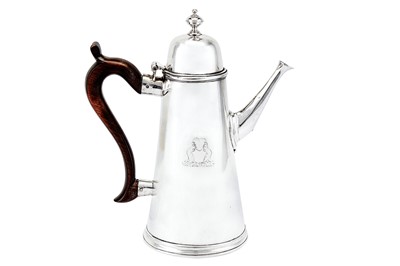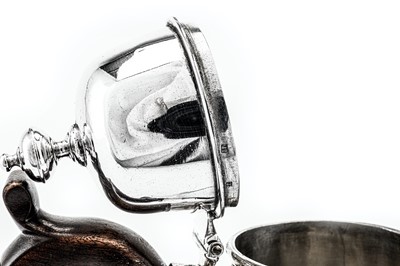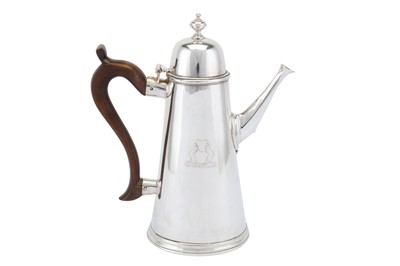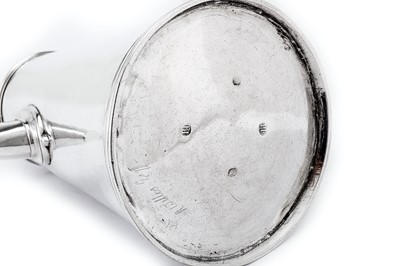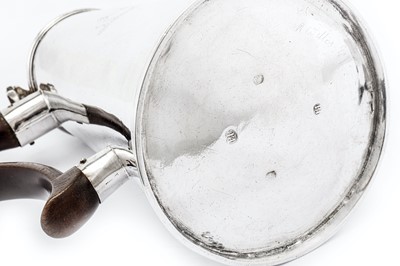25th Mar, 2020 14:00
Silver & Objects of Vertu
An extremely rare George I English provincial silver coffee pot, Liverpool circa 1725 by Benjamin Brancker (active until 1734)
An extremely rare George I English provincial silver coffee pot, Liverpool circa 1725 by Benjamin Brancker (active until 1734)
of tapering cylindrical “lighthouse” form with moulded rims, the hinged domed lid surmounted by a compressed knop finial. The shaped panelled spout opposite a wooden C scroll handle. Engraved to the side with a contemporaneous crest of a two lion's gambs erect and erased holding a human heart gules. Marked underneath with makers mark BB twice and STER over LING twice, the lid unmarked. Also scratched underneath “R. Willis esq.”.
Height – 24 cm / 9.5 inches
Weight – 780 grams / 25.08 ozt
The crest is for Willis of Halsnead Park and Hall-of-the-Hill, Lancashire
For Thomas Willis, a Liverpool merchant, who in 1684 purchased the estate of Halsnead. He died unmarried in 1727.
The complicated history of the Willis family's ownership of Halsnead is explained in William Farrer and J. Brownbill, editors, Victoria County History, A History of the County of Lancaster (1907, vol. 3, pp. 348-352): 'In 1684 Thomas Willis, a merchant of Liverpool, purchased Halsnead and settled there. He had a son Martin, whose children Thomas and Daniell dying without issue, Halsnead went to their cousin Thomas, grandson of William Swettenham of Swettenham, by his wife Bertha, daughter of Thomas Willis. The heir took the name of Willis, but his son Thomas dying without issue in 1788, another cousin of Daniell Willis, by his mother's side, succeeded. This was Ralph Earle, who took the name of Willis. He died two years later, when his son and heir Richard came into possession and held it till his death in 1837. He was succeeded by his sons Richard, Joseph, and Daniell in turn; the last of these died in 1873, and his son Henry Rodolph D'Anyers Willis, in 1902; the latter's son Richard Atherton D'Anyers Willis, born in 1871, is the present lord of the manors of Whiston and Halsnead.'
Benjamin Brancker, who is known to have been working in Liverpool from the early years of the 18th century, was succeeded in business by his son John in 1734. For further information, including details of his petition in 1715 to the Corporation of Chester to become a freeman of that city, see Maurice H. Ridgway, Chester Goldsmiths from Early Times to 1726, John Sherratt & Son Ltd., Altringham, 1968, pp. 123-124; and Ian Pickford, editor, Jackson's Silver and Gold Marks of England, Scotland and Ireland, third edition, Antique Collectors' Club, Woobridge, pp. 413-415.
Other examples of work bearing Brancker's mark include a brandy saucepan, circa 1720 from the collection of Mrs. Elizabeth and the late Dr. Edward F. Rosenberg, Christie's, New York, 10 December 1986, lot 111; and a teapot, circa 1720, illustrated in Michael Clayton, Christie's Pictorial History of English and American Silver, p. 124, no. 2.
Another coffee pot of very similar form to the present example, with a similarly distinctive spout, is in the Liverpool Museum.
provencance, sold Christie's South Kensington, 21 Sep 2004, Lot 277 (£23,302 incl. premium)
Do you have an item similar to the item above? If so please click the link below to submit a free online valuation request through our website.

